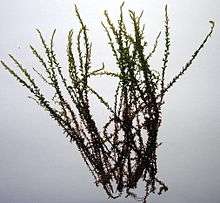Calliergon cordifolium
Calliergon cordifolium is a species of moss in the Calliergonaceae family,[2][3] commonly known as the calliergon moss (though this name refers to the genus Calliergon generally)[1] or heart-leaved spearmoss.[4] The species is abundant in the right habitat, and grows in marshes and wet woodland,[5] especially woodland of alder (Alnus) or willow (Salix),[6] as well as around streams, ditches and pools. The species grows in tufts among other moss species. Calliergon cordifolium requires a wet environment to grow, and often grows completely submerged in water. It typically prefers lowland, but has been recorded as high as 910 metres (1,000 yd) above sea level in Inverness, Scotland.[7] The species has a circumpolar Boreo-temperate distribution. It is found throughout Europe (including north, into the Arctic Circle - Svalbard, the Faeroe Islands, Iceland and Greenland - and east into the Caucasus). It has been recorded in north and central Asia, as well as Turkey and Japan, throughout North America and in New Zealand.[7]
| Calliergon cordifolium | |
|---|---|
 | |
| Scientific classification | |
| Kingdom: | Plantae |
| Division: | Bryophyta |
| Class: | Bryopsida |
| Subclass: | Bryidae |
| Order: | Hypnales |
| Family: | Calliergonaceae |
| Genus: | Calliergon |
| Species: | C. cordifolium |
| Binomial name | |
| Calliergon cordifolium | |
Calliergon cordifolium is a medium-sized to large moss with erect, green shoots. The shoots can reach up to 15 centimetres (5.9 in), with egg-shaped leaves from 2 to 2.5 millimetres (0.079 to 0.098 in) wide. The leaves extend outwards, away from the stem. Towards the base, the leaves take on a heart shape, while, at the tip, they are rounded. The spore-bearing capsules are rarely seen,[5] and are encountered only in spring or summer. The spores measure 10 to 16 micrometres across.[7] Calliergon cordifolium can be mistaken for similar species, including Calliergon giganteum, Calliergonella cuspidata,[5] Straminergon stramineum and Pseudocalliergon trifarium.[7]
References
- "Calliergon cordifolium (Hedw.) Kindb". United States Department of Agriculture. Retrieved 16 June 2012.
- Goffinet, B.; Buck, W. R.; Shaw, A. J. (2008). "Morphology and Classification of the Bryophyta". In Goffinet, B.; Shaw, J. (eds.). Bryophyte Biology (2nd ed.). New York: Cambridge University Press. pp. 55–138. ISBN 978-0-521-87225-6.
- Goffinet, B.; Buck, W.R. "Classification of extant moss genera". Classification of the Bryophyta. Retrieved 1 May 2020.
- Edwards, Sean R. (2012). English Names for British Bryophytes. British Bryological Society Special Volume. 5 (4th ed.). Wootton, Northampton: British Bryological Society. ISBN 978-0-9561310-2-7. ISSN 0268-8034.
- Tom Blockeel (2010). "Calliergon cordifolium" (PDF). In I. Atherton; S. Bosanquet; M. Lawley (eds.). Mosses and Liverworts of Britain and Ireland. British Bryological Society. p. 719. ISBN 9780956131010.
- James Holmes Dickson. Bryophytes of the Pleistocene: The British Record and Its Chorological and Ecological Implications. Cambridge University Press. p. 145. ISBN 9780521085762.
- A. J. E. Smith & Ruth Smith (2004). The Moss Flora of Britain and Ireland. Cambridge University Press. p. 787. ISBN 9780521546720.